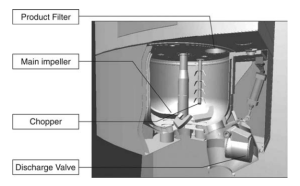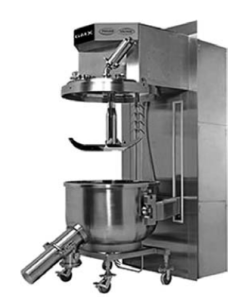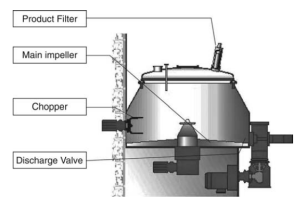There are a lot of things to be learnt about the rapid mixer granulator. Before we proceed, lets take a look at the what granulation is really.
Granulation processes are among the most widely practiced unit processes in pharmaceutical finished form manufacturing.
It is also referred to as agglomeration and can be used to improve powder flow properties and reduce fine dust through size enlargement and densification, thus improving tableting operations.
Frequently, granulation provides the means to intimately combine a thermoplastic binder with other formulation components, thus improving compactibility of tablet formulations.
Granulation is also used to prevent powder segregation, thereby ensuring uniform drug distribution. This is especially important in low-dose, high-potency drugs.
The rapid mixer granulator is also known as the high shear mixer.
This requirement of adequate flowability, density, and compressibility is particularly important during a high-speed tablet production where the dwell time is often short.
For example, active pharmaceutical ingredients such as ibuprofen and acetaminophen, which have inadequate flow and compression properties, and a relative high dose, are often granulated prior to compression into tablets.
Thus, the overall purpose of granulation is to improve the flowability and compressibility of the powder mixture.

Besides improving the flowability and compressibility, the granulation process can also;
- Ensure uniform distribution of the drug in the powder mixture,
- Narrow the particle size distribution of the powder mixture,
- Densify the powder mixture and reduce dust,
- Improve the dissolution characteristics of the finished tablets
The three commonly used granulation methods include wet granulation, dry granulation, and hot-melt granulation.
These methods are categorized on the basis of the type of binder and the process employed during granulation.
The equipment that is used during the granulation processes is classified into the following three major categories on the basis of the shearing strength it generates on the powder bed during the granulation process:
- Low-shear granulators
- Medium-shear granulators, for example, fluid-bed granulators with a rotogranulator attachment
- High-shear granulators/Rapid mixer Granulator
In this write up, we will be looking at the Rapid mixer Granulator.
Types of high rapid mixer granulator/high shear granulator
Most of the conventionally used high-shear granulators consist of a mixing bowl, a three bladed impeller, and an auxiliary chopper. The shape of the mixing bowl can be cylindrical or conical.
The mixing bowl can be jacketed for heating or cooling the contents in the bowl, by circulating hot or cool liquid or steam through the jacket.

An impeller is employed to mix the dry powder and to spread the granulating fluid. The impeller of the high-shear mixer granulator normally rotates at a speed ranging from 100 to 500 rpm.
The function of the chopper is to break down the wet lumps into granules. The rotation speed of the chopper ranges from 1000 to 3000 rpm.
The high-shear granulator could be termed as either vertical or horizontal, on the basis of the orientation and the position of the impeller. The vertical high shear granulator could be either a top- or bottom-driven unit.
A high-shear wet granulation process includes the following steps:
Loading all the ingredients into the mixing bowl by either of the following methods: Manually charging the bowl, gravity feeding with manual or pneumatic valve, and vacuum feeding.
Mixing of dry ingredients such as API, other excipients, and disintegrant (optional), with an impeller and chopper at high-speed settings for a short period of time (2–5 minutes)
Addition of a liquid binder (either binder solution or solvent) into the powder mixture, while both the impeller and the chopper are running at a low speed
Wet massing with both the impeller and the chopper running at a high speed (this can vary depending on product)
Wet milling and screening (most desirable) l Removal of the resulting wet granules from the granulator bowl, and drying them using an appropriate drying technique such as fluid bed or tray drying l Sieving the dried granules.
Advantages of rapid mixer granulator
The high-shear wet granulation process offers several advantages over the other granulation processes. These include;
- Short processing time
- Use of less binder solution
- Granulation of highly cohesive materials containing hydrophilic polymers, which is not achievable with low-shear granulation processes
- Greater densification and production of less friable granules than the low-shear granulated product
- Production of reproducible granules with a uniform particle size distribution
- Reduction of process dust, thus minimizing exposure to workers during the subsequent processing
- Obtaining predictable granulation end point determination.

Disadvantages of the rapid mixer granulator
- Overwet, harder granules could produce less compressible granules compared with low-shear granulation processes and
- Narrow range of operating conditions.
Factors affecting the granulation process
Factors affecting granulation process include;
- Process variable and
- Formulation variables.
Effects of Process Variables
Process variables play a critical role in defining various granular properties of the final granules. Generally, formulations are developed in R&D scale granulators and then scaled up to production-scale granulators.
Significant differences exist between laboratory and production models of granulators in terms of design, shape, size, speed, and geometry of the granulator bowl, impellers, and choppers.
Even though the composition of the formulation is similar, the physical properties of the obtained granules could be dramatically different because of the differences between granulators used at the development scale and the production scale.
These differences could significantly affect the physical properties of the granules, which in turn could affect the properties and performance of the final tablets. The understanding of various process factors is the key to successful tech transfer in product development process.
Effect of Formulation Variables
Binders Classification and Characteristics The binders used in wet granulation process can be broadly classified into three categories: binders derived from natural, semisynthetic, or synthetic origins, and polysaccharides and sugars.
Editor’s Picks
Sticker labeling machine; Types, benefits, costs, and maintenance
Liquid filling machine; types, functions, features 2023
References
Chirkot T, Propst C. Low shear granulation. In: Parikh DM, ed. Handbook of Pharmaceutical Granulation Technology. 2nd ed. Boca Raton: Taylor & Francis Group, 2005:229–245.
Schaefer T, Holm P, Kristensen HG. Comparison between granule growth in a horizontal and a vertical high speed mixer. II. Granulation of lactose. Arch Pharm Chem, Sci Ed 1986; 14:17–29.
